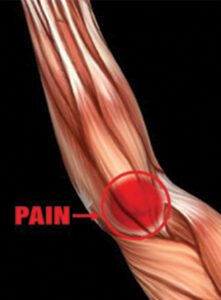 While golf has often been considered a low-impact physical activity without great risk for injury, damage to the ankle, Golfer’s elbow, known as medical epicondylitis, is among the leading injuries for golfers. This is the inflammation of the tendons that attach your forearm muscles to the end of the arm bone in the elbow area. A tight grip on the golf club and frequent repetitive motions over time can cause the forearm muscles and tendons to become damaged from overuse, resulting in pain and tenderness in the elbow.
While golf has often been considered a low-impact physical activity without great risk for injury, damage to the ankle, Golfer’s elbow, known as medical epicondylitis, is among the leading injuries for golfers. This is the inflammation of the tendons that attach your forearm muscles to the end of the arm bone in the elbow area. A tight grip on the golf club and frequent repetitive motions over time can cause the forearm muscles and tendons to become damaged from overuse, resulting in pain and tenderness in the elbow.
You can combat the development of golfer’s elbow by incorporating a few precautionary steps into your routine. First and foremost, it is essential to stretch before you begin your day on the golf course, focusing on shoulders, back and legs. Stretching before tee time will help your body to best promote a fluid and full range of motion for your golf swing. Once you have warmed up and stretched, hit the driving range to practice your drive.
One of the most successful ways to avoid developing golfer’s elbow is to strengthen the muscles in your forearm and slow your golf swing so that your arm will absorb less shock upon hitting the golf ball. For the best results, try the following exercises from the American Academy of Orthopaedic Surgeons:
• Squeeze a tennis ball. Squeezing an old tennis ball for 5 minutes at a time is simple, but do not overdo it. Progressive strengthening avoids recurrent injury.
• Wrist curls. Use a lightweight dumbbell. Lower the weight to the end of your fingers, and then curl the weight back into your palm, followed by curling up your wrist to lift the weight an inch or two higher. Perform 10 repetitions with one arm, and then repeat with the other arm.
• Reverse wrist curls. Use a lightweight dumbbell. Place your hands in front of you, palm side down. Using your wrist, lift the weight up and down. Hold the arm that you are exercising above your elbow with your other hand in order to limit the motion to your forearm. Perform 10 repetitions with one arm, and then repeat with the other arm.
Incorporate these exercises into your regular routine to ensure that your body is prepared to tee off this spring. Another form of stretching, not mentioned in medical textbooks for the treatment of elbow inflammation is simple swimming. Swimming makes you stretch out the tendon on both sides of your elbows.
Many common sports injuries offer warning signs, such as swelling, reduced range of motion, numbness and tingling, muscle tenderness and joint pain. When caught early, simple treatments such as resting, applying hot or cold compresses and taking over-the-counter pain relievers are often enough to improve the symptoms. If pain persists, more intensive therapies, such as anti-inflammatory medications or injections or physical therapy, may be required to address the issue. Other more serious problems require arthroscopic diagnosis and surgical options may be considered.
If you are experiencing pain caused by a golf or other sports-related injury, make an appointment to speak with orthopedic a specialist. Dr. Edward R. Dupay, Jr. and his staff are ready to answer all of your questions.
Edward R. Dupay, Jr, DO
Board Certified
Dr. Dupay graduated from Xavier University in Cincinnati, Ohio. He received his Doctor of Osteopathy at the University of Health Sciences, College of Osteopathic Medicine in Kansas City, Missouri.
Dr. Dupay completed his Internship and Orthopedic Surgery Residency at Flint Osteopathic Hospital in Flint, Michigan. Dr. Dupay has been in the Fort Myers / Cape Coral area since 1987. Dr. Dupay enjoys seeing the “Weekend Warrior” athlete, as well as all patients suffering from crippling osteoarthritis.
To schedule your appointment, please call Orthopedic Associates of Southwest Florida at 239-768-2272, visit our website at www.ifixbones.com, or ask your physician for a referral.









